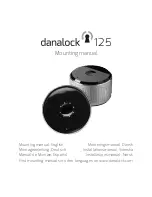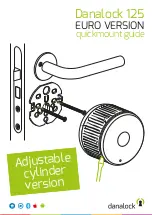
24
Gently turn to the right (clockwise)
approximately
1
⁄
8
" (3 mm),
figure 12-1
.
A slight click should be felt.
Do not force.
IMPORTANT:
When removing the screwdriver,
the central piece must return to its initial
position, if not, set it back to its original
position using the screwdriver; see
Section 9
.
Verify the Combination Change Assembly
.
4)
Turn the outside thumbturn to the left
(counterclockwise) to the stop position,
once only, to clear the existing code from
the mechanism, then release it.
5)
Select a new code and write it down
(some or all of the buttons may be used
for your new code, pressed individually
or simultaneously).
NOTE:
Each button may be used only once.
6)
With the
door open
, enter your new code.
Depress each button fully and release.
7)
Turn the outside thumbturn to the right
(
A
) (clockwise) to the stop position. The
latch should retract. Now release the
thumbturn. Try to turn the thumbturn to
the right (clockwise). The thumbturn will
not turn to the right (clockwise) unless the
correct combination is entered. If it does
turn and retracts the latch, see
Step 9
.
NOTE:
Excessive force will result in slipping
the thumbturn 180˚ degrees. The slipping
mechanism, or force-proof clutch, protects the
lock’s internal mechanism from forced entry.
8)
If a wrong combination is entered after the
desired combination has been programmed
into the lock, turn the outside thumbturn to
the left (
B
) (counterclockwise) to the stop
position and release,
figure 12-2
.
This will clear any previously depressed
buttons. Enter the correct new combina
tion. Turn the thumbturn to the right (
A
)
(clockwise) to the stop position and
release,
figure 12-2
. The thumbturn
should rotate. The latch will be retracted
flush with the face plate. The correct
combination must be entered each time
you want to unlock the door.
3)
Inserte un destornillador Phillips en el
centro del cilindro de cambio de combi-
nación. Hágalo girar suavemente hacia la
derecha (en el sentido de las agujas de
reloj) unos 3 mm (
1
⁄
8
pulg.),
ilustración
12-1
. Deberá oir un leve chasquido.
No aplique fuerza.
IMPORTANTE:
al retirar el destornillador,
la pieza central deberá volver a su posición
original. Si no lo hace, utilice el destornillador
para moverla a dicha posición. Véase
la sección 9, Verificación del cilindro de
cambio de combinación.
4)
Gire la manija exterior una sola vez hacia
la izquierda (en sentido contrario al de las
agujas de reloj) hasta que se detenga;
luego gírela lentamente hacia la derecha
(en el sentido de las agujas de reloj) hasta
que llegue a su posición horizontal.
Esto anulará la combinación actual
del mecanismo.
5)
Seleccione una combinación nueva y
anótela (para crear su nueva combi-
nación, usted puede usar algunos botones
o todos, oprimidos individual o
simultáneamente).
OBSERVACIÓN:
cada uno de los botones
puede usarse una sola vez.
6)
Con la
puerta abierta
, ponga su
nueva combinación. Oprima cada botón
completamente y luego suéltelo.
7)
Haga girar la manija exterior hacia la
derecha (en el sentido de las agujas de
reloj) hasta que llegue al tope. El pestillo
deberá replegarse. Ahora suelte la manija.
Trate de girar la manija hacia la derecha
(en el sentido de las agujas de reloj). La
manija no girará a menos de que se opri
ma la combinación correcta. Si la manija
gira y el pestillo se mueve, siga las
instrucciones del paso 9.
OBSERVACION
: si se fuerza la manija,
patinará 180º. Este mecanismo de patinaje, o
embrague a prueba de fuerza, protege el mecanis-
mo interno de la cerradura contra los intentos
de abrirla por la fuerza.
PK0782/02/02 Impos. 1/29/03 4:52 PM Page 24









































